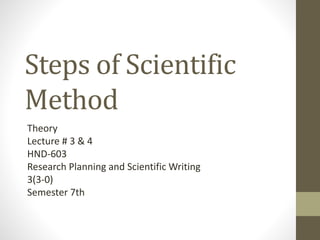
Steps of Scientific Method.pptx
- 1. Steps of Scientific Method Theory Lecture # 3 & 4 HND-603 Research Planning and Scientific Writing 3(3-0) Semester 7th
- 2. Contents • Scientific method • Introduction • Steps of scientific method • Practical Example • Summary
- 3. Introduction to the Scientific Method • A logical, problem solving technique
- 4. Introduction to the Scientific Process Identify a problem Gather Information Formulate a hypothesis Design and Experiment Record and Organize Data Analyze Data Draw Conclusions Use conclusions to develop a new hypothesis
- 5. Step 1: Identify a Problem • Observe the world around you • Using observations, identify a problem you would like to solve • This is a question you DO NOT know the answer to and can’t look up. • “Why” and “What would happen if..” are good beginnings of scientific questions.
- 6. Step 2: Gather Information • Use references to do background research • Books • Journals • Magazines • Internet • TV • Videos • Interview Experts www.goldstarexterminators.net
- 7. Step 3: Formulate a Hypothesis • Possible answer to a question that can be tested • Based on observations and knowledge • “If” “Then” “Because” statement • Example: If soil temperature rises, plant growth will rise Do we use observation or inference to formulate a hypothesis?
- 8. Step 4: Develop an Experiment Materials: • Induce a detailed material list • Supplies Procedure • Step by step instructions • Identifies the variables used in the experiment How would you describe how to make a Peanut Butter and chicken Sandwich to someone who had never done it? To someone who didn’t know what peanut butter?
- 9. Step 5: Analyze Data • “Modify the procedure if needed • Confirm the result by retesting • Compare and look for trends and patterns using graphs
- 10. Step 6: Make Conclusions • You must repeat the experiment to make the data valid • You should run your experiment at least 3 times to confirm your results • You can run all the experiments at one time, or run one after the other • Each separate experiment is called a Repetition (or Rep).
- 11. Step 7: Communicate the Result • Be prepared to present the project to the audience. • Except question from the audience.
- 12. Problem/ Question • John watches his grandmother • bake a bread • He asked his grandmother what • makes the bread rise. • She explains that yeast releases • a gas as it feeds on sugar
- 13. Observation/ Research • John research the areas of baking fermentation • To test his question • He keeps all his information in a journal
- 15. Formulate a Hypothesis • If more sugar is added, then more bread will rise • Educated guess • Relationship between independent and dependent variables
- 16. Independent Variable • Factor that intentionally varied by the experimenter. • Example: • Amount of Sugar 25g, 50g,100g, 250g, 500g Dependent Variable • Factor that change due to change independent variable. • Example: Size of loaf
- 17. Control Group • Serve as standard of comparison • No treatment • Exposed to same conditions • Except for variable being tested • Grandmother uses 50g of sugar • Jonh use the amount in his control group
- 18. Constants • Keep all other factors same • Observe changes in bread • Due to sugar amount • Example • Bread recipe, oven used rise time, cooking time, type of pan temperature and humidity, Age of yeast
- 19. Experiment • John writes out his procedure along with material list • Trial: John test each sugar variable 3 times
- 20. Collect and analyze the result • John use table to gather data Size of bread loaf Amount of sugar g 1 2 3 Average size cm2 25 768 744 761 758 50 control group 1296 1188 1296 1296 100 1188 1080 1080 1116 250 672 576 588 612 500 432 504 360 432
- 21. • John rejected his hypothesis • Retest using amount of sugar between 50g to 100g • Once again gather his material and carries out his experiment
- 22. Size of Baked Bread Size of bread loaf Amount of sugar g 1 2 3 Average size cm2 50 1296 1440 1296 1344 60 1404 1296 1440 1380 70 1638 1638 1560 1612 80 1404 1296 1296 1332 90 1080 1200 972 1084
- 23. Conclusion • John finds that 70g of sugar produces the largest loaf. His hypothesis is accepted
- 24. Communicate the result • John tell his grandmother • Prepares the project to present in his science class
- 25. Summary • What is Question ? • Gathered all the information related to experiment. • Hypothesis either approved or rejected. • Performed the experiment • Collected and organized the results. • Conclusion • Shared the information
Editor's Notes
- Who is the scientist?
- Develop a question or problem that can be solved through experimentation
- Develop and follow a procedure, A list of all the things you need
- Collect and analyze the data Tables, graphs and photographs
- Include statement that accept or reject the hypothesis Make recommendations for further study and possible improvements to the procedure
- John wonders if the amount of sugar used in the recipe will affect the size of bread loaf
- Johns talks with his teacher
- All experiment should have control group
- The constant in experiment are all factors that the experimenter attempt to keep the same Variation in sugar amount
- Trial: Refer to replicate groups that are exposed to same condition
- Notices his control work the best
- 9